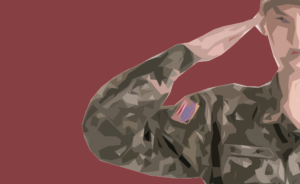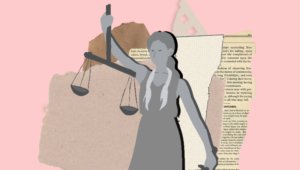Explore the art of D.C.’s streets through our interative map below.
[leaflet-map lat=38.9138 lng=-77.0453 zoom=12 width=50% zoomcontrol=true]
[leaflet-marker mouseoverable=true up_first=true lat=38.9161 lng=-77.0213 title=”“DC to the World”” author=”Gustav Honl-Stuenkel” img=”https://georgetownvoice.com/wp-content/uploads/2018/03/DCtotheWorld.jpg”]
Plastered on the side of Kiss Lounge on Florida Avenue is the “DC to the World” mural, a blue, black, and gray retrospective on the musical influence the District has had on international culture. The mural—like many in the city—is a bit of a hidden gem, nestled between two busy streets in north-central D.C., waiting to be found by nighttime revelers and urban explorers. In her art, Cita Sadeli Chelove, often emphasizes multiculturalism and pride in her Indonesian roots. This same sense of respect for one’s ancestors is evident in “DC to the World”, which features three D.C.-based artists.
On the far left of the mural is hip-hop artist Wale, who has family in Nigeria; in the center is rapper Oddisee, whose father is Sudanese; and on the right is R&B singer Kelela, whose parents emigrated from Ethiopia. All three artists are distinctly contemporary, showing how Washington’s cultural influence will continue through the development of hip-hop and R&B, even as the artists stay connected to their diverse roots. The mural’s simple coloration leaves room for both nostalgia and imagination, and allows Chelove to accent her figures with unique character traits. The small pink hearts floating on Kelela’s right and the piano built into Oddisee’s shoulder reward a trip to the alleyway to see the mural.
Photo Credit: Gustav Honl-Stuenkel/The Georgetown Voice
Design Credit: Jack Townsend and Alex Lewontin/The Georgetown Voice[/leaflet-marker]
[leaflet-marker mouseoverable=true opacity=.5 lat=38.9044 lng=-77.0702 title=”Graffiti Cliffs of Georgetown” author=”Mary Mei” img=”https://georgetownvoice.com/wp-content/uploads/2018/03/IMG_0389.jpg”]
Graffiti is arguably street art in its most original form, and the well-known Graffiti Cliffs of Georgetown near the Key Bridge are no exception. A favorite Instagram spot for locals and visitors alike, the colorfully decorated precipice is most popular at sunset, when people pose for pictures against the vibrant walls, the sun dipping over the Potomac in the distance.
The site is a quiet enclosure away from the bustling traffic of M Street. Most come for the photos, but the cliff is also a hospitable hangout location, and the faint smell of marijuana lingers in the air.
Despite its popularity (and notable presence on social media), there is actually a clear “Area Closed” sign posted on the low fence surrounding the cliff and its sprayed stone walls. Visitors tend to ignore this as they climb over the metal bars.
There’s something incredibly appealing about the vibrant, graffiti-covered concrete contrasting the clean, white facade of the nearby monuments, suggesting that these cliffs are and will continue to be a local monument in themselves.
Photo Credit: Mary Mei/The Georgetown Voice
Design Credit: Jack Townsend and Alex Lewontin/The Georgetown Voice[/leaflet-marker]
[leaflet-marker mouseoverable=true opacity=.5 lat=38.9079 lng=-77.0695 title=”Wave House” author=”Brynn Furey” img=”https://georgetownvoice.com/wp-content/uploads/2018/03/DSC_0793-1.jpg”]
The beauty of the Wave House comes from its history and spontaneity. Inspired by “The Great Wave off Kanagawa,” a woodblock print by the Japanese artist Hokusai, the image induces both ominous as well as calming emotions, a difficult task to accomplish. While he was working in Washington during the summer of 1974, Harvard architecture student John McConnell painted the replica on O Street. The idea developed “during a delicious dinner with lots of good wine.” The idea of a young student making a living in D.C. during a hot ’70s summer and impulsively deciding to paint a work of art on the side of a Georgetown house using nothing other than Sherwin-Williams house paint sounds like something out of a John Hughes movie.
Every Georgetown student is familiar with this classic and beautiful piece. Take it from Leigh Ann Fairley (COL ’19) who has a tapestry of “The Great Wave off Kanagawa” in her apartment. “The giant mural of the wave near Saxby’s is a classic spot for Instagrams, and its proximity to Saxbys makes it extremely visible in our daily lives. I chose to purchase a tapestry of it in my apartment because it is so iconic of Georgetown, and also because it fills our space with calm tones of blue,” Farley said. Whether walking back from Safeway with heavy bags or pushing to get to the front gates at the end of a run to the monuments, the Wave House mural adds a little bit of beauty to even the most mundane and difficult moments of life on the Hilltop.
Photo Credit: Brynn Furey/The Georgetown Voice
Design Credit: Jack Townsend and Alex Lewontin/The Georgetown Voice[/leaflet-marker]
[leaflet-marker mouseoverable=true lat=38.9000 opacity=.5 lng=-77.0411 title=”Police and Fire Call Boxes” author=”Mike Bergin” img=”https://georgetownvoice.com/wp-content/uploads/2018/03/CallBoxes.jpg”]
If you have spent significant time in D.C., you will have likely noticed these fixtures adorning the edges of sidewalks all over the Metro area. These cast iron boxes, now repurposed and redecorated, are part of the District’s past. Before the time of telephones, these boxes were part of D.C.’s infrastructure, used by the city’s police and fire personnel for check-ins since the 1860s. Varying from a traditional house frame to harp-shaped, they were simple, hard-wired phones—red for fire, blue for police.
There were even two special brass boxes, one in front of the White House and one in front of Union Station, used by Teddy Roosevelt when arriving back at the Capital by train.
Many cities tore their boxes up as they became obsolete. In D.C., they were left to rust as they stood. This changed in 2000 with Cultural Tourism DC’s Art on Call initiative. Protecting many of the over 1100 abandoned boxes found, the initiative helped turn 145 of them into monuments to the public art of the community as of 2002.
The small posts have become small representatives of their neighborhoods. The firebox outside the Shaw neighborhood library contains a miniature of the nearby sculpture “Vivace” by Craig Kraft. Although only a few inches tall, it scales the massive work beautifully, showing a rainbow broken apart into chromatic tendrils. Often literal reflections of the neighborhood, the repainted police box near the corner of Pennsylvania Ave and 18th Street is hard to place at first. You have to spin around to realize it captures the view of the distant corner of the Eisenhower Building, a perspective that can only be seen from standing in front of the box, decorated in warm colors in a late, Romantic revivalist style, harkening back to the early formation of our nation’s government on the shores of the Potomac.
Photo Credit: Mike Bergin/The Georgetown Voice
Design Credit: Jack Townsend and Alex Lewontin/The Georgetown Voice[/leaflet-marker]
[leaflet-marker mouseoverable=true lat=38.9250 opacity=.5 lng=-77.0226 title=”“College is Key”” author=”Inès de Miranda” img=”https://georgetownvoice.com/wp-content/uploads/2018/03/CollegeIsKey6-1.jpg”]
A couple of streets over from Howard University, Juan Pineda’s mural “College is Key” pays homage to the historically black university in both title and appearance. The phrases “Academic Excellence” and “Howard University” and representatives of the diverse aspects of Howard life—football players, nurses, graduates, administrators, Miner Hall—don the mural’s walls.
The only brightness on the mural comes from Howard’s school colors: blue, red, and white. Pineda’s painted rays make the black-and-white snapshots stand out and bring patriotic streamers to mind.
Mike Brandon, a senior citizen who lives next to the mural, picked up loose newspaper pages and floating plastic bags blown in front of his house from the alley. He talked about years of Howard students walking past and the rich history of the university. “[The mural] is a part of a larger effort in the neighborhood to mind its history and pay tribute to Howard University,” Brandon said.
Photo Credit: Inès de Miranda/The Georgetown Voice
Design Credit: Jack Townsend and Alex Lewontin/The Georgetown Voice[/leaflet-marker]
[leaflet-marker mouseoverable=true lat=38.9174 opacity=.5 lng=-77.0288 title=”“The Torch”” author=”Amy Guay” img=”https://georgetownvoice.com/wp-content/uploads/2018/03/TheTorch7-3.jpg”]
Round the corner of the iconic red and yellow storefront of U Street’s original Ben’s Chili Bowl and you’ll be met by the Obamas. Flanked by Prince and wreathed loosely in an American flag, the former President and First Lady beam out from a brick wall emblazoned with more than a dozen black visionaries. This is “The Torch,” a 2017 mural conceived and painted by prolific street artist Aniekan Udofia with help from art director Mia Duval. “The Torch” is a testament to Ben’s long history of community-driven projects—the restaurant had customers vote to determine which figures would be portrayed—as well as a vibrant tribute to D.C. black pride.
With his trademark vividness, Udofia serves the 16 black leaders featured in “The Torch” well. His subjects are postured nobly while playful background accents like a streak of electric pink or disembodied purple speakers add colorful hints of magic. There’s also a palpable sense of movement within the mural: Singer Roberta Flack’s red scarf whips in the invisible breeze, the same wind that sweeps the green material draped around Harriet Tubman. The District’s own Congresswoman Eleanor Holmes Norton is proudly swathed in a rippling D.C. flag, its stars and stripes a visual counterpoint to the fabric encircling the Obamas. “We are D.C.,” the mural seems to say. “And D.C. is America.”
Photo Credit: Amy Guay/The Georgetown Voice
Design Credit: Jack Townsend and Alex Lewontin/The Georgetown Voice[/leaflet-marker]




